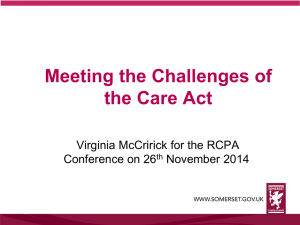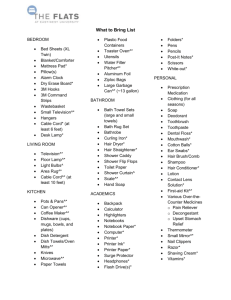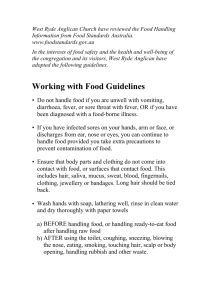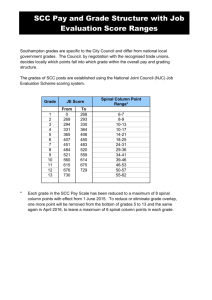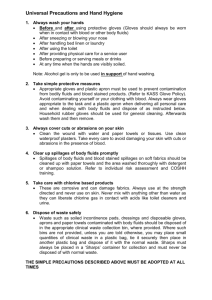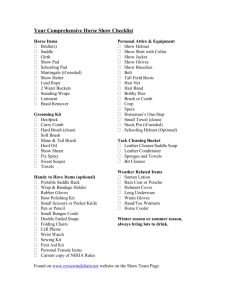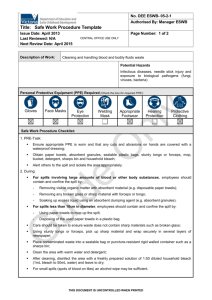Infection Control for blood and body fluids
advertisement
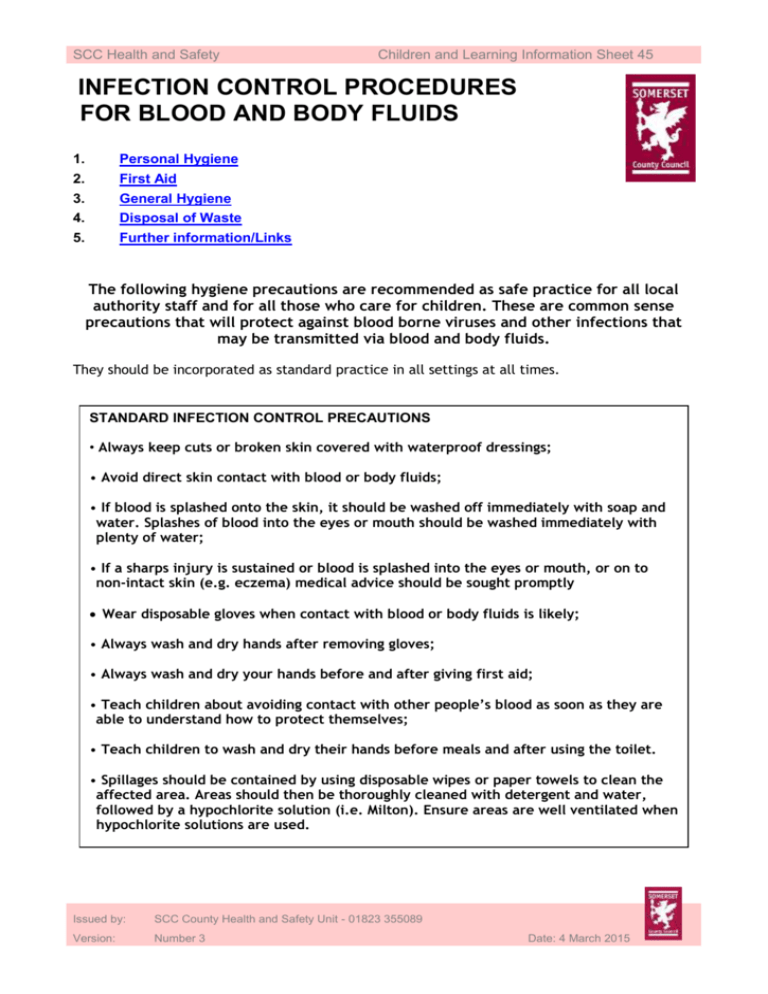
SCC Health and Safety Children and Learning Information Sheet 45 INFECTION CONTROL PROCEDURES FOR BLOOD AND BODY FLUIDS 1. Personal Hygiene 2. First Aid 3. General Hygiene 4. Disposal of Waste 5. Further information/Links The following hygiene precautions are recommended as safe practice for all local authority staff and for all those who care for children. These are common sense precautions that will protect against blood borne viruses and other infections that may be transmitted via blood and body fluids. They should be incorporated as standard practice in all settings at all times. STANDARD INFECTION CONTROL PRECAUTIONS • Always keep cuts or broken skin covered with waterproof dressings; • Avoid direct skin contact with blood or body fluids; • If blood is splashed onto the skin, it should be washed off immediately with soap and water. Splashes of blood into the eyes or mouth should be washed immediately with plenty of water; • If a sharps injury is sustained or blood is splashed into the eyes or mouth, or on to non-intact skin (e.g. eczema) medical advice should be sought promptly Wear disposable gloves when contact with blood or body fluids is likely; • Always wash and dry hands after removing gloves; • Always wash and dry your hands before and after giving first aid; • Teach children about avoiding contact with other people’s blood as soon as they are able to understand how to protect themselves; • Teach children to wash and dry their hands before meals and after using the toilet. • Spillages should be contained by using disposable wipes or paper towels to clean the affected area. Areas should then be thoroughly cleaned with detergent and water, followed by a hypochlorite solution (i.e. Milton). Ensure areas are well ventilated when hypochlorite solutions are used. Issued by: SCC County Health and Safety Unit - 01823 355089 Version: Number 3 Date: 4 March 2015 SCC Health and Safety Children and Learning Information Sheet 45 1. Personal hygiene o o o o Razors, toothbrushes or other implements, which could become contaminated with blood, must not be shared. Dispose of these implements if there is a risk of/have been contaminated. Minor cuts, open or weeping skin lesions and abrasions should be covered with waterproof or other suitable dressings, once the wound has been cleaned. Sanitary towels must be burnt in an incinerator or the procedure for disposal of infected waste followed (see below). Tampons may be flushed down the toilet. 2. First aid 2.1 Accidents involving external bleeding: o o o 2.2 Splashes of blood from one child on to another: o o 2.3 Normal first aid procedures should be followed, which should include the use of disposable gloves where possible (NOTE: some persons may be allergic to latex gloves) Wash the wound immediately and copiously with water; apply a suitable dressing and pressure pad if needed Seek medical advice as soon as possible if there is any doubt. Splashes of blood on the skin should be washed off immediately with soap and water Splashes of blood into the eyes or mouth should be washed out immediately with copious amounts of water. Resuscitation o o o Where staff are trained in the use of a face shield or pocket mask for hygiene purposes when giving resuscitation (“rescue breaths”) then they should use it. If a first aider does not have a mask or shield with them, they should not hesitate to give rescue breaths. The advice given in the authorised first aid manual of the first aid providers should be followed Record the details on a Data Collection form for input on the EEC website ‘Accident Reporting’ module. 3. General hygiene o o o Normal cleaning methods should be used; no special disinfectants are necessary for either the bath or toilet Use disposable cloths/paper towels Separate cloths should be used for the kitchen, the bathroom and the toilet. 3.1 Note on the use of chlorine based sterilizing agents o Agents such as domestic bleach or Milton’s Fluid (sodium hypochlorite solution) “bleach tablets” (calcium hypochlorite) or NADCC granules (sodium dichloroisocynarate) work by the release of chlorine. Issued by: SCC County Health and Safety Unit - 01823 355089 Version: Number 3 Date: 4 March 2015 SCC Health and Safety o o Children and Learning Information Sheet 45 Agents such as those described above require the completion of a COSHH assessment as instructed by the Control of Substances Hazardous to Health Regulations 2002. When using agents to clean spillages etc., the COSHH assessment should be consulted as some agents may damage surfaces or need to be applied under specific conditions. Further guidance on hazardous substances and completing a COSHH assessment can be obtained from the Hazardous Substances policy. 3.2 Cleaning spillages of blood or body fluids o o o Household grade gloves and a disposable plastic apron should be worn when cleaning splashes or spillages. Eye protection should be considered if there is a risk of splashing. Gloves should be washed with neutral detergent and hot water after use. Hands should always be washed and dried on removal of gloves. Use gel granules, (e.g. ‘Sanitaire’ Emergency Clean up) when removing vomit. . 4. Disposal of waste (Appendix A) o o o o o o o Paper towels, together with gloves and aprons, should be put into a plastic waste sack prior to disposal, the top tied and placed in a household waste bag for collection. Waste such as sanitary towels, nappies, tampons and incontinence pads should be wrapped adequately in newspaper to soak up excess fluid prior to disposal in a household waste bag. Vomit, urine and faeces should be flushed down the toilet. Potties and Nappy-changing mats should be washed with neutral detergent and hot water, and dried with paper towels after each use. Where it is not possible to dispose of vomit or body waste down the toilet, the waste should be collected using sanitary waste bags and disposed in the same way as other sanitary waste contract arrangements the school/educational establishment has. Surfaces such as carpets should be ‘steam cleaned’ and it is recommended that a professional cleaner is called upon to undertake this activity. Where there is regular generation of significant amounts of waste contaminated with body fluids, it should be regarded as clinical waste and disposed of appropriately. This should be via a designated clinical waste collection service. In some individual cases, a child’s general practitioner may identify a specific infection risk associated with their medical condition and may make additional arrangements for disposal of waste via the local authority This should be discussed with the general practitioner and local infection control team or pediatric community nursing service. 5. Further advice/links Direct link to this document is: https://slp.somerset.org.uk/ipost/iPost%20Documents/Guidance%20for%20Schools%20%20Infection%20Control%20for%20blood%20and%20body%20fluids%20-%20info%20sheet%2045.doc EEC Health and Safety website (for completing infection control/bodily fluids risk assessments) https://www.eeclive.co.uk/public/plogon.asp?AID=14 Form 08 – COSHH Assessment template: http://extranet.somerset.gov.uk/EasySiteWeb/GatewayLink.aspx?alId=36360 Health Protection Agency main website: http://www.hpa.org.uk/HPAwebHome/ Issued by: SCC County Health and Safety Unit - 01823 355089 Version: Number 3 Date: 4 March 2015 SCC Health and Safety Children and Learning Information Sheet 45 Health Protection Agency - Spotty book – Infectious diseases in schools and childcare settings: http://www.hpa.org.uk/webc/HPAwebFile/HPAweb_C/1317133613717 Health Protection Agency – Infection control in schools and child care settings poster: Infection control in schools and childcare settings Norovirus Information and Letter to schools template (provided by Health Protection Agency): https://slp.somerset.org.uk/ipost/iPost%20Documents/Advance%20Norovirus%20letter%20to%20s chools%20October%202014.doc SCC Hazardous Substances Policy (HS008): http://extranet.somerset.gov.uk/EasySiteWeb/GatewayLink.aspx?alId=35434 Viral Gastroenteritis (Norovirus) Outbreak guidance (On Somerset Learning Platform): https://slp.somerset.org.uk/ipost/iPost%20Documents/Viral%20Gastroenteritis%20(Norovirus)%20 Outbreak%20Guidance.doc Appendix A Hard surfaces e.g. floor tiles, impervious table tops, baths Small spills or splashes of blood Large spills Clean with neutral detergent and hot water Remove spillage as much as possible using absorbent paper towels Flush these down toilet or dispose of carefully in waste bag Cover remaining with paper towels soaked in diluted bleach solution (1:10 dilution with cold water) Leave for up to 30 minutes, and then clear away. Alternatively, large spills may be covered with sodium dichloroisocyanurate (NADCC) granules for two minutes. Spillage and granules should be carefully removed with paper towels and disposed carefully into waste bag. Clean area with neutral detergent and hot water. Note 1: chlorine will be released when NADCC granules are used - it is important that the area is well ventilated. These granules should not be used on spillages of urine Note 2: chlorine based agents are likely to damage carpets, fabrics, metal and wood and should not be used on these surfaces Soft surfaces and fabrics e.g. carpets and chairs Remove the spillage as far as possible using absorbent paper towels, Then clean with a fresh solution of neutral detergent and water. Carpets and upholstery can then be cleaned using cleaner of choice. Steam cleaning may be considered. Issued by: SCC County Health and Safety Unit - 01823 355089 Version: Number 3 Date: 4 March 2015 SCC Health and Safety Crockery and cutlery Linen and clothing Children and Learning Information Sheet 45 Crockery and cutlery can be cleaned in the normal way either by hand washing with detergent or in a dish washer 1. Household gloves and cold running water should be used to remove soil prior to washing if necessary, and any solid matter (i.e. faeces and vomit) should be flushed down the toilet 2. Wash in a domestic machine at the highest temperature the fabric can withstand. 3. In residential/day care/special schools it is recommended that an industrial washing machine be used. Soiled linen/clothing does not need to be sluiced in this instance with a sluice prewash programme. 4. Care should be taken to avoid splashing body fluids into the mouth or eyes. Issued by: SCC County Health and Safety Unit - 01823 355089 Version: Number 3 Date: 4 March 2015

